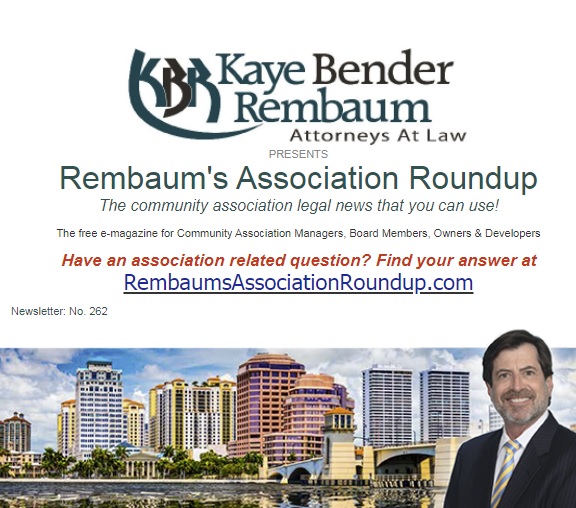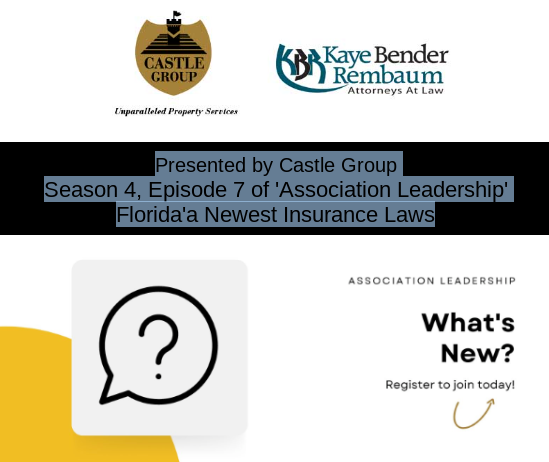COMMUNITY ASSOCIATION WEBSITES
By Eric Glazer, Esq.
As you all know by now, Florida condominiums having 150 or more units must have a website that only owners can access and which posts the official records of the association. Here’s a little background as to how the law was passed. When originally drafted, the law was only to apply to condominiums with 500 or more units. That was ridiculous. So, I flew up to Tallahassee and met with the then Speaker of the House and informed him that the law was a fake, inasmuch as less than one percent of all condominiums in the state contained 500 or more units. I suggested 50 units. The compromise was 150.
I never heard one person tell me this was a bad law. In fact, it’s a great law. It’s about transparency. It takes the burden off of managers having to respond to requests for records. It prevents lawsuits or arbitrations, as long as the website is kept up to date.
Just because the law requires condominiums of 150 units or more to have a website does not mean that condominiums of less than 150 units cannot have a website. In fact, in this attorney’s opinion, if your condominium contains 50 units or more, you can and should have a website for the same reason that condominiums with 150 units should.
Think about how large some HOAs are. Many contain well in excess of 500 homes and are sprawling mini cities. You would think that those communities should be required to post their records on an official website as well. But no. HOAs are not required to have a website. There is simply a hands off approach when it comes to HOAS.
Again, just because the law requires condominiums of 150 units or more to have a website does not mean that HOAs cannot have a website. In fact, in this attorney’s opinion, if your HOA contains 50 homes or more, you can and should have a website for the same reason that condominiums with 150 units should.
This is one law the legislature should amend. All communities, both condos, co-ops and HOAs with 50 or more units or homes should be required to have a community association website where the official records and notices of meetings are posted. Bottom line…….it will make the residents less suspicious and happier.
Community associations, whether condominiums, co-ops, or HOAs, are responsible for providing transparency to their owners. One way to achieve this is through a community association website. In Florida, the state recognizes the importance of transparency in community associations and requires condominiums with 150 or more units to have an owners-only website that posts official records. However, this requirement should extend beyond just large condominiums.
Community associations of all sizes should consider having their website to give owners transparency. Even if a community does not meet the state-mandated requirement, having a website is still a good idea.
A website can provide owners with easy access to official records, notices of meetings, and other important information. It can also help reduce the burden on managers to respond to document requests. Additionally, it can prevent lawsuits or arbitrations if the website is kept up-to-date. It’s about more than just meeting legal requirements. It’s about providing owners with a sense of transparency and openness. This can build trust between the board, management, and owners and foster a happier community.
However, it’s important to note that the community association website should be more comprehensive than just the required information. It should also include commonly asked questions, how to apply to the association, how to pay fees, and other relevant information owners may need. This will help to make the website more user-friendly and informative for owners.
In conclusion, having a community association website is essential for transparency, no matter the size of the community. It can build trust and create a more positive living experience for all owners. The state of Florida has recognized the importance of transparency in condominiums, and it is time for all community associations to follow suit by establishing their websites with informative content.
I guess the Florida Legislature thought they did a great job to assure transparency in condominiums when they enacted bills in 2017 and 2018 [FS 718.111(12)(g)], that required condominium associations with more than 150 units to operate a website featuring all so-called “public documents”.
They would have done a great job — the bills were actually well intended – if there would be as well some sort of enforcement.
In the real world we are seeing lots of totally incomplete websites, only showing what board members and CAMs want the owners to see – and otherwise it’s business as usual.
The fights over record requests are keeping arbitrators and courts busy – and the attorneys are still smiling at their bank account statements.
If the legislators thought that they finally found a solution to end litigation about association records they were dead wrong.
Everybody knows that laws without enforcement are pretty useless and all these laws created each year are only laws for the rich, meaning the folks who have enough money to hire attorneys and fight for their rights, given to them by these kinds of laws, in district and appeals courts.
Wouldn’t that mean that all these laws, created year for year adding to the community association statutes, are only LAWS FOR THE RICH?
Every other owner who might dare to mention at a board meeting that the board is violating statutes can still be told by the association attorney: “Sit down and shut up. You don’t have the money to sue the association!”
Read more industry articles on Florida HOA & Condo Blog –
Tags:
Board of Directors,
Condo and HOA Law,
Web Site Design Articles









 Believe it or not, it’s getting harder to sue someone or to sue a business in the State of Florida.
Believe it or not, it’s getting harder to sue someone or to sue a business in the State of Florida.



